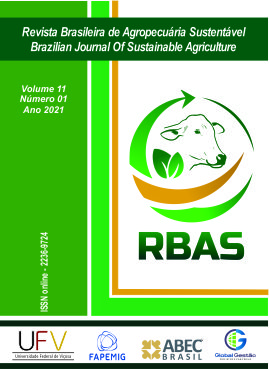MUDAS DA PALMEIRA BURITI TEM BAIXA EXIGÊNCIA HÍDRICA EM VASOS COM SOLO
DOI:
https://doi.org/10.21206/rbas.v11i1.10141Keywords:
Mauritia flexuosa; propagation; waterAbstract
The swamp palm (Mauritia flexuosa L.f.) is a palm tree that occurs in the Brazilian Amazon, Pantanal and Cerrado biomes and occupies wetlands such as the Cerrado swamps. Because of this association and its high size, swamp palm has been used as an indicator of preserved areas. As it is still explored extractively, little has been investigated about its propagation. Seedlings of 90 days developed from seeds in cylindrical tubes (290 cm3) with substrate (composted pine bark) were prepared. An essay was carried out in a completely randomized design with five treatments, 10 repetitions and one seedling per plot (pot). The maximum water retention capacity (MWRC) of a red dystrophic oxisol, with 20% clay, was estimated in a 12-liter pot. The sifted soil was incubated with lime for 30 days with irrigation for 60% of the MWRC and fertilized with N, P, K, S and B. The treatments were flood, 100%, 75%, 50% and 25% of MWRC. The pots were kept in a greenhouse with plastic cover and irrigated daily to replace the water after weighing. Biometric variables were evaluated after four months: stem diameter, shoot length, fresh and dry mass, shoot root ratio, Dickson quality index and water content. Swamp palms irrigated with 25% of MWRC presented the lowest stem diameter, fresh and dry mass, Dickson quality index and water content. The supply of water with 50% of the MWRC allowed swamp palm seedlings to grow as well as those that received more water: 75, 100% of the MWRC or flood. In conclusion, the swamp palm seedlings (M. flexuosa) developed properly with daily irrigations with 50% of MWRC in 12-liter pot with soil.
Downloads
Downloads
Published
How to Cite
Issue
Section
License
Copyright (c) 2021 Brazilian Journal of Sustainable Agriculture

This work is licensed under a Creative Commons Attribution-NonCommercial-NoDerivatives 4.0 International License.
1. Proposta de Política para Periódicos de Acesso Livre
Autores que publicam nesta revista concordam com os seguintes termos:
Autores mantém os direitos autorais e concedem à revista o direito de primeira publicação, com o trabalho simultaneamente licenciado sob a Licença Creative Commons Attribution que permite o compartilhamento do trabalho com reconhecimento da autoria e publicação inicial nesta revista.












